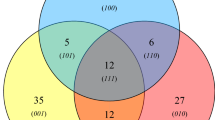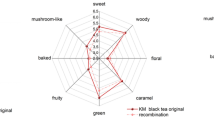Abstract
Jasmine tea is quite popular in daily consumption and beverage industry, and scenting quality and synthetic artificial oil are crucial issues of its quality control. The headspace volatile profiles of jasmine tea samples were analyzed by headspace-solid phase microextraction (HS-SPME) coupled with GC-MS. Twenty-nine volatile compounds were determined as ‘common components’ that should exist in jasmine scented teas. Potential correlation was discovered between quality grade of jasmine tea and the ratio of peak area percentage of α-farnesene, (Z)-3-hexenyl benzoate, methyl anthranilate, and indole to that of linalool. This ratio was denoted as ‘jasmine tea flavor’ (JIF) index, a novel index for quality evaluation of jasmine tea. JTF index and common components could provide a good identification of well-scented, poor-scented, and not-scented jasmine teas. Moreover, carrier compounds might be a clear evidence for identifying fake jasmine teas that were added with synthetic fragrance oil.
Similar content being viewed by others
References
Ye NX, Yang G, Zheng NH, Yang JF, Wang ZK, Liang XX. Effects of wet-scenting process and RJF on the aroma constituent of jasmine scented tea. J. Tea Sci. 26: 65–71 (2005)
Inoue N, Kuroda K, Sugimoto A, Kakuda T, Fushiki T. Autonomic nervous responses according to preference for the odor of jasmine tea. Biosci. Biotech. Bioch. 67: 1206–1214 (2003)
Kuroda K, Inoue N, Ito Y, Kubota K, Sugimoto A, Kakuda T, Fushiki T. Sedative effects of the jasmine tea odor and (R)-(-)-linalool, one of its major odor components, on autonomic nerve activity and mood states. Eur. J. Appl. Physiol. 95: 107–114 (2005)
Hara Y, Luo S, Wiickremasinghe LR, Yamanishi T. Processing of tea. Food Rev. Int. 11: 409–434 (1995)
Wang LF, Lee JY, Chung JO, Baik JH, So S, Park SK. Discrimination of teas with different degrees of fermentation by SPME-GC analysis of the characteristic volatile flavour compounds. Food Chem. 109: 196–206 (2008)
Yamanishi T. Aroma of Chinese scented green tea. pp. 181–190. In: Frontiers of Flavor. Proceedings of 5th International Flavor Conference. July 1–3, Porto Karras, Chalkidiki, Greece. Elsevier Science Publishers BV, Amsterdam, Netherlands (1987)
Liang YR, Wu Y, Lu JL, Zhang LY. Application of chemical composition and infusion color difference analysis to quality estimation of jasmine-scented tea. Int. J. Food Sci. Tech. 42: 459–468 (2007)
Ito Y, Sugimoto A, Kakuda T, Kubota K. Identification of potent odorants in Chinese jasmine green tea scented with flowers of Jasminum sambac. J. Agr. Food Chem. 50: 4878–4884 (2002)
Augusto F, Zini CA. Sampling and sample preparation for field and laboratory: Fundamentals and new directions in sample preparation. pp. 389–478. In: Solid Phase Microextraction. Pawliszyn J (ed). Elsevier, Amsterdam, Netherlands (2002)
Lee JH, Min DB. Analysis of volatile compounds from chlorophyll photosensitized linoleic acid by headspace solid-phase microextraction (HS-SPME). Food Sci. Biotechnol. 19: 611–616 (2010)
Lin J, Zhang P, Pang Z, Xu H, Luo Y, Wang X. Discrimination of oolong tea (Camellia sinensis) varieties based on feature extraction and selection from aromatic profiles analyzed by HS-SPME/GCMS. Food Chem. in press doi: 10.1016/j.foodchem.2013.02.128 (2013)
Lin J, Dai Y, Guo YN, Xu HR, Wang XC. Volatile profile analysis and quality prediction of longjing tea (Camellia sinensis) by HSSPME/ GC-MS. J. Zhejiang Univ. Sci. B 13: 972–980 (2012)
Chinese National Standard. Jasmine tea. GB/T 222922008. General Administration of Quality Supervision, Inspection and Quarantine, and Standardization Administration of the People’s Republic of China, Beijing, China (2008)
Chinese National Standard. Methodology of sensory evaluation of tea. GB/T 237762009. General Administration of Quality Supervision, Inspection and Quarantine, and Standardization Administration of the People’s Republic of China, Beijing, China (2009)
Edris AE, Chizzola R, Franz C. Isolation and characterization of the volatile aroma compounds from the concrete headspace and the absolute of Jasminum sambac (L.) Ait. (Oleaceae) Xowers grown in Egypt. Eur. Food Res. Technol. 226: 621–626 (2008)
Han NC, Zhen DG, Wang Y. Study on the mechanism of tea leaves absorbing jasmine fragrance compounds. Southwest China J. Agr. Sci. 4: 40–45 (1991)
Ma J. Study on changes of aroma and other physical and chemical factors during scenting processes of jasmine tea. MS thesis, Graduate School of Chinese Academy of Agricultural Sciences & Tea Research Institute, Hangzhou, Zhejiang Province, China (2001)
Huang XA. Preliminary study on constitution analysis and formation mechanism of the aroma of jasmine tea and flowers of Jasminum sambac. MS thesis, Anhui Agricultural University, Hefei, Anhui Province, China (2001)
Owuor PO, Tsushida T, Horita H, Takeo T, Murai T. Differentiation of clonal teas by terpene index. J. Sci. Food Agr. 40: 341–345 (1987)
Hu QH, Xu J, Pan GX. Effect of selenium spraying on green tea quality. J. Sci. Food Agr. 81: 1387–1390 (2001)
Jiang GW, Liao MH, Li YJ. Difference analysis of aromatic composition of jasmine tea prepared with fresh jasmine flowers and spiked jasmine flavoring. Tea Commun. 32: 17–20 (2005)
Ueyama Y, Hashimoto S, Nii H, Furukawa K. The chemical composition of the flower oil and the leaf oil of Michelia alba D.C. J. Essent. Oil Res. 4: 15–23 (1992)
Author information
Authors and Affiliations
Corresponding author
Rights and permissions
About this article
Cite this article
Lin, J., Chen, Y., Zhang, P. et al. A novel quality evaluation index and strategies to identify scenting quality of jasmine tea based on headspace volatiles analysis. Food Sci Biotechnol 22, 331–340 (2013). https://doi.org/10.1007/s10068-013-0085-x
Received:
Revised:
Accepted:
Published:
Issue Date:
DOI: https://doi.org/10.1007/s10068-013-0085-x




